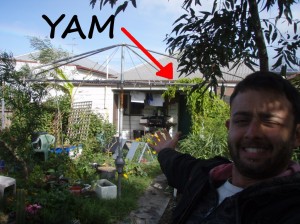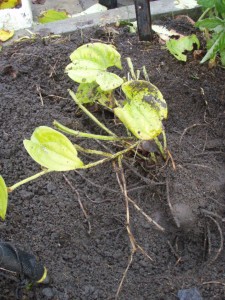As the weather cools down through Autumn and Winter a lot of tuber producing plants start to die back which means…Â HARVESTING TIME!!!

An interesting one I dug up this winter was my Greater Yam (Dioscoria alata). There are a very large variety yams, over 850 species, but the most commonly grown is the Greater Yam. The vine grows to 2.5m wide and 3m tall so likes to climb a tree or sturdy frame, a bamboo tripod over a well composted mound works well. Its dense, attractive heart-shaped foliage provided an excellent breeding ground for Praying mantis’ over the summer which are beneficial predators of grasshoppers and locusts.
The tubers of the Greater Yam have a course brown skin and either red or white flesh. One plant can produce one to a number of tubers ranging in size depending on situation, in the ideal conditions tubers have been known to reach over 60kg! Provide the plant with ample water through its growing season in the warm weather for best results and harvest in late Autumn.

I found removing the tubers safely from the ground can be quite tricky as they can run dense and deep…. just think of the bonza harvest! If any are damaged during extraction you can remove the damaged pieces and let the clean cuts heal in a sheltered dry place. These pieces can be grown into new plants! I ended up with about 15kg of Yams, plenty of large ones to eat and small ones to propagate for next season.
As far as storage and consumption; yams heal well and store for a long while in a cool dry place. Once peeled, the Greater Yam can be boiled then pounded into a kind of dough or cut into chips and fried. I found the taste quite like a nutty potato… the texture being far from potato but still enjoyable as chips. I’m sure it’d be nice cut thinly and dried as crisps or…. anything! Calls for experimentation!

